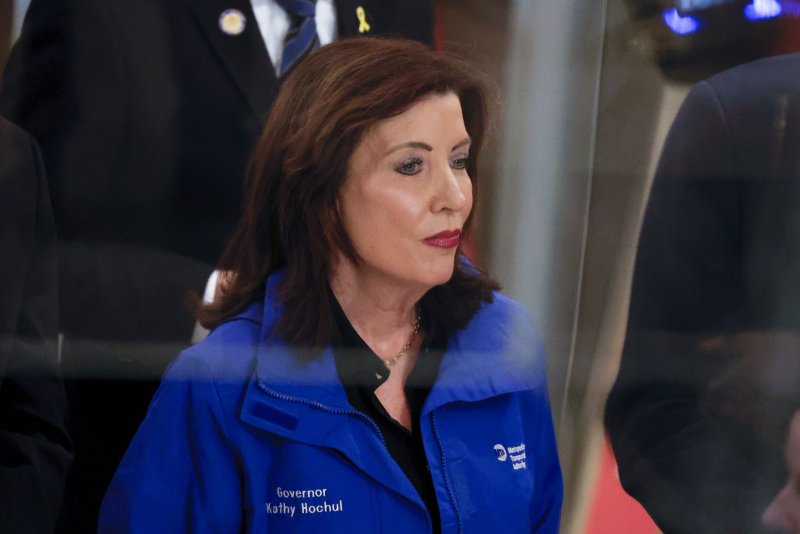1 of 4 | New York Gov. Kathy Hochul speaks to the media following President Trump’s efforts to kill New York’s congestion pricing at Grand Central on Wednesday in New York City. Trump’s U.S. Department of Transportation, directed by Transportation Secretary San Duffy, is moving to put an end the Manhattan toll program. Photo by John Angelillo/UPI |
License PhotoFeb. 19 (UPI) — U.S. Department of Transportation Secretary Sean Duffy on Wednesday announced his agency will end New York City’s congestion pricing enacted by the state.
President Donald Trump, whose Manhattan home is in the congestion zone, vowed to kill the toll soon after he took office.
The White House posted on X posted a statement by Trump: “CONGESTION PRICING IS DEAD. Manhattan, and all of New York, is SAVED. LONG LIVE THE KING!” -President Donald J. Trump.
Duffy told Gov. Kathy Hochul in a letter the agency is ending the tolling structure that went into effect on Jan. 5. The date for the end wasn’t listed.
“New York State’s congestion pricing plan is a slap in the face to working class Americans and small business owners,” Duffy wrote in the letter. “Every American should be able to access New York City regardless of their economic means. It shouldn’t be reserved for an elite few.”
He said the system contradicts the federal highway program, which does not allow tolling on roads built with federal funds unless Congress exempts it.
“Commuters using the highway system to enter New York City have already financed the construction and improvement of these highways through the payment of gas taxes and other taxes,” he wrote. “But now the toll program leaves drivers without any free highway alternative, and instead, takes more money from working people to pay for a transit system and not highways.”
The program had a $9 toll for drivers entering Manhattan south of 60th Street during peak traffic hours and $2.25 overnight to enter Manhattan below 60th Street, known as the congestion relief zone.
Conversely, it also created discounts for lower-income drivers and exemptions for others.
Scanners monitor license plates. Those with EZ Pass tags are charged via their accounts and others without them are mailed a bill.
Metropolitan Transportation Authority, which is in charge of managing the toll program, immediately filed a 51-page federal lawsuit to stop the order.
Jano Lieber, chair and chief executive of the Metropolitan Transportation Authority, called it a “baseless effort” to remove benefits the program of a decrease in traffic, faster travel times and increased speeds for emergency vehicles.
“It’s mystifying that after four years and 4,000 pages of federally supervised environmental review — and barely three months after giving final approval to the Congestion Relief Program — USDOT would seek to totally reverse course,” Lieber said.
The lawsuit listed the benefits of the program
About 1.2 million fewer vehicles entered the zone in January, which is a 7.5% decrease from January 2024, according to the MTA. Also, it took up to 30% less time during rush hour to travel across bridges and through tunnels into lower Manhattan that month. And times across 34th Street were cut nearly in half.
More people visited lower Manhattan business areas, according to preliminary data from the MTA. In January, around 36 million people visited business districts in the zone, about 1.5 million people more than January 2024. Attendance at Broadway shows also rose 17% in January from the previous year.
Congestion pricing was approved by state legislators in 2019 to reduce traffic in Midtown and lower Manhattan, and also raise a revenue stream that would allow the MTA to issue $15 billion in bonds for its 2019-2024 capital program
Hochul blasted the decision and promised legal action.
“Public transit is the lifeblood of New York City and critical to our economic future — as a New Yorker, like President Trump, knows very well,” Hochul said in a statement.
“We are a nation of laws, not ruled by a king. The MTA has initiated legal proceedings in the Southern District of New York to preserve this critical program. We’ll see you in court.”
Congestion pricing has been in effect in Singapore cities; Gothenburg and Stockholm, Sweden; London, England; and Milan, Italy.
